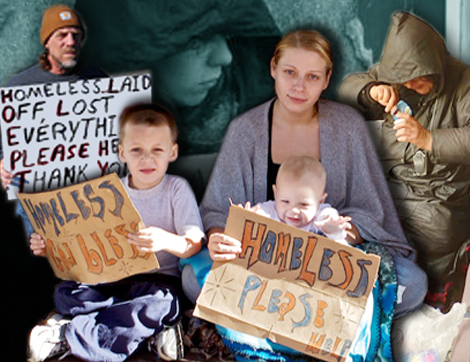
• Worst humanitarian crisis in nation’s history threatens United States
By Keith Johnson
You don’t need to thumb through a history book to find snapshots of Americans suffering through a great depression. Today, the poverty stricken are more visible than ever. They’re living in cars, under freeway bypasses and camping out in tent cities that are popping up around the country.
Hard times are upon us, and the empirical evidence is there to prove it. Last year, the Bureau of the Census, more commonly referred to as the United States Census Bureau, introduced a new way of measuring poverty by adding in those with incomes less than 50% above the poverty line. According to an article in The New York Times, “That number of Americans is 76% higher than the official account, published in September [2011]. All told, that places 100M people—one in three Americans—either in poverty or in the fretful zone just above it.”
When the Bureau releases its data for 2011 later this fall, those numbers are expected to be even worse. A recent survey conducted by Associated Press found a broad consensus among more than a dozen economists, think tanks and academics who concluded: “The official poverty rate will rise from 15.1% in 2010, climbing as high as 15.7%. Several predicted a more modest gain, but even a 0.1 percentage point increase would put poverty at the highest since 1965.”
Add in those whom the Bureau now classifies as “near poor,” and it is plain to see that the American people are on the precipice of grappling with the greatest humanitarian crisis in their nation’s history.
For many, the crisis has already begun. The results of a recent Gallup poll survey, conducted from January to June, indicate that almost one in five Americans have struggled to find food to feed their families.
“Nationwide, 18.2% of Americans so far in 2012 say there have been times when they could not afford the food they needed, on par with the 18.6% who had trouble affording food in 2011,” Gallup reported.
For America’s children, the situation is particularly heart wrenching. Earlier this year, the United Nations Children’s Fund, UNICEF, reported that the U.S. had a child poverty rate of 23.1%, higher than any developed nation outside of Romania.
And things are bound to get worse. According to the 2012 edition of “Kids Count,” a frequently quoted survey produced by the Annie E. Casey Foundation, child poverty increased by nearly a third between 2000 and 2005, rose another 16% between 2005 and 2010, and jumped a dramatic 22% during the first two years of the “global recession,” which began in 2008.
But for some regions of the nation, where the impending foreclosure crisis continues to devastate local economies, the rate of child poverty is rising even faster.
This AMERICAN FREE PRESS reporter recently spoke with Debbie Leon, development director for Pathways to Home, a homeless outreach program based in Sanford, Florida. “In 2007, there were 600 homeless children in Seminole County,” said Ms. Leon. “Today it’s over 2,000. That should give you some idea of how bad things are.”
Ms. Leon said that things are so dire in her neck of the woods, more than 100 families are waiting to receive assistance from her organization.
“When people think of the homeless, they think of the man on the street holding up a sign,” Ms. Leon added. “But now we’re starting to see entire families doing the same thing.”
And it’s not just the former homeowner whose family has become destitute as a result of the foreclosure crisis. According to Ms. Leon: “You also have those who are renting. And when the person they’re renting from is foreclosed on, they’re also out of a place to live. A lot of Americans live paycheck to paycheck. Because of that, they have very little saved away and are unable to find affordable [replacement] housing.”
Thousands of miles away, in poverty-plagued Fresno, California, this AFP reporter heard a similar story. “We’re not seeing a lot of people come in who’ve had their homes foreclosed on, but rather those who were renting from them,” said Reverend Larry J. Arce, CEO of the Fresno Rescue Mission.
Arce went on to say: “We’ve clearly seen a surge [in poverty] over the past 10 years, particularly among women, children and returning veterans. Several years ago, the Brookings Institution found us to have the highest poverty rate in the country. In fact, they referred to us as ‘new Appalachia.’”
But Arce is quick to point out that Fresno may not hold that title for long. “I also sit on the board of directors for the Association of Gospel Rescue Missions,” said Arce. “So I get to see a lot of what’s going on across the country, and I can tell you that our situation is becoming far less unique.”
So what’s do be done? If the 2012 presidential race is any indication, then we shouldn’t expect much. Though Obama pledged during his 2008 run “to cut poverty in half within 10 years,” he has taken very few steps in that direction. And, as Paul Tough puts it in a recent article for The New York Times: “as a political issue, especially during this presidential campaign season, poverty has receded almost to silence.”
Keith Johnson is a writer based in Tennessee.

